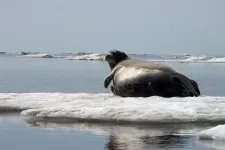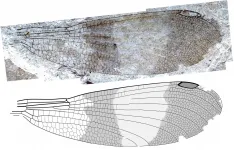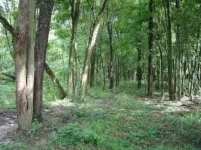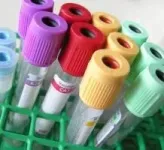Ancient skeletal hand could reveal evolutionary secrets
A 4.4 million-year-old skeleton could show how early humans moved and began to walk upright, according to new research led by a Texas A&M anthropology professor
2021-02-24
(Press-News.org) Evolutionary expert Charles Darwin and others recognized a close evolutionary relationship between humans, chimps and gorillas based on their shared anatomies, raising some big questions: how are humans related to other primates, and exactly how did early humans move around? Research by a Texas A&M University professor may provide some answers.
Thomas Cody Prang, assistant professor of anthropology, and colleagues examined the skeletal remains of Ardipithecus ramidus ("Ardi"), dated to 4.4 million years old and found in Ethiopia. One of Ardi's hands was exceptionally well-preserved.
The researchers compared the shape of Ardi's hand to hundreds of other hand specimens representing recent humans, apes and monkeys (measured from bones in museum collections around the world) to make comparisons about the kind of locomotor behavior used by the earliest hominins (fossil human relatives).
The results provide clues about how early humans began to walk upright and make similar movements that all humans perform today.
This discovery is described in a study published in the current issue of Science Advances.
"Bone shape reflects adaptation to particular habits or lifestyles - for example the movement of primates - and by drawing connections between bone shape and behavior among living forms, we can make inferences about the behavior of extinct species, such as Ardi, that we can't directly observe, Prang said.
"Additionally, we found evidence for a big evolutionary 'jump' between the kind of hand represented by Ardi and all later hominin hands, including that of Lucy's species (a famous 3.2 million-year-old well-preserved skeleton found in the same area in the 1970s). This 'evolutionary jump' happens at a critical time when hominins are evolving adaptations to a more human-like form of upright walking, and the earliest evidence for hominin stone-tool manufacture and stone-tool use, such as cut-marks on animal fossils, are discovered."
Prang said the fact that Ardi represents an earlier phase of human evolutionary history is important because it potentially shines light on the kind of ancestor from which humans and chimpanzees evolved.
"Our study supports a classic idea first proposed by Charles Darwin in 1871, when he had no fossils or understanding of genetics, that the use of the hands and upper limbs for manipulation appeared in early human relatives in connection with upright walking," he said. "The evolution of human hands and feet probably happened in a correlated fashion."
Since Ardi is such an ancient species, it might retain skeletal features that were present in the last common ancestor of humans and chimpanzees. If this is true, it could help researchers place the origin of the human lineage - in addition to upright walking - into a clearer light.
"It potentially brings us one step closer to an explanation for how and why humans evolved our form of upright walking," Prang said.
He added that the big change in hand anatomy between Ardi and all later hominins occurs at a time, roughly between 4.4 and 3.3 million years ago, coinciding with the earliest evidence of the loss of a grasping big toe in human evolution. This also coincides with the earliest known stone tools and stone cut-marked animal fossils.
He said it appears to mark a major change in the lifestyle and behavior of human relatives within this timeframe.
"We propose that it involves the evolution of more advanced upright walking, which enabled human hands to be modified by the evolutionary process for enhanced manual manipulation, possibly involving stone tools," Prang said
INFORMATION:
This research was funded by the Wenner Gren Foundation.
ELSE PRESS RELEASES FROM THIS DATE:
2021-02-24
A study co-authored by scientists at the New England Aquarium has found that known deaths of critically endangered North Atlantic right whales represent a fraction of the true death toll. This comes as the death of a calf and recent sightings of entangled right whales off the southeastern United States raise alarm.
The study, published this month in END ...
2021-02-24
Ithaca, NY-- During mating season, male bearded seals make loud calls to attract a mate--even their "quiet" call could still be as ear-rattling as a chainsaw. Bearded seals have to be loud to be heard over the cacophony of their equally loud brethren. And, increasingly, the noise humans make is adding to the underwater din and could have serious consequences. A study conducted by the Cornell Lab of Ornithology's Center for Conservation Bioacoustics (CCB) aims to understand how resilient bearded seals can be to changes in ambient underwater noise. The results are published in Proceedings of the Royal Society: Biological Science.
"We wanted to know whether bearded seals would call louder when ...
2021-02-24
Researchers at Stevens Institute of Technology have developed a new machine learning-powered platform, known as OC-SMART, that can process ocean color in satellite images 10 times faster than the world's leading platform. The work, which will be adopted by NASA, is one of the first machine learning-based platforms in ocean color analysis that can process both coastal and open ocean regions globally to reveal data on sea health and the impact of climate change.
The work, led by Knut Stamnes, a physics professor at Stevens, and spearheaded by Yongzhen Fan Ph.D. '16, a visiting physics scholar in Stamnes' lab, solves a 30-year-old problem in retrieving data from both coastal regions and open ocean areas. For decades, NASA's SeaDAS platform exceled at analyzing ocean color ...
2021-02-24
For more than 150 years, scientists have been incorrectly classifying a group of fossil insects as damselflies, the familiar cousins of dragonflies that flit around wetlands eating mosquitoes. While they are strikingly similar, these fossils have oddly shaped heads, which researchers have always attributed to distortion resulting from the fossilization process.
Now, however, a team of researchers led by Simon Fraser University (SFU) paleontologist Bruce Archibald has discovered they aren't damselflies at all, but represent a major new insect group closely related to them.
The findings, published today in Zootaxa, show that the distinctive shape of the insect's non-protruding, ...
2021-02-24
When people hear botulinum toxin, they often think one of two things: a cosmetic that makes frown lines disappear or a deadly poison.
But the "miracle poison," as it's also known, has been approved by the F.D.A. to treat a suite of maladies like chronic migraines, uncontrolled blinking, and certain muscle spasms. And now, a team of researchers from Harvard University and the Broad Institute have, for the first time, proved they could rapidly evolve the toxin in the laboratory to target a variety of different proteins, creating a suite of bespoke, super-selective ...
2021-02-24
A Brazilian study published (http://www.nature.com/articles/s41467-020-20217-w) in Nature Communications shows that human activities have directly or indirectly caused biodiversity and biomass losses in over 80% of the remaining Atlantic Rainforest fragments.
According to the authors, in terms of carbon storage, the biomass erosion corresponds to the destruction of 70,000 square kilometers (km²) of forest - almost 10 million soccer pitches - or USD 2.3 billion-USD 2.6 billion in carbon credits. "These figures have direct implications for mechanisms of climate change mitigation," they state in the article.
Atlantic Rainforest remnants ...
2021-02-24
DALLAS - Feb. 24, 2021 - Using machine learning tools to analyze hundreds of proteins, UT Southwestern researchers have identified a group of biomarkers in blood that could lead to an earlier diagnosis of children with autism spectrum disorder (ASD) and, in turn, more effective therapies sooner.
The identification of nine serum proteins that strongly predict ASD were reported in a study published today by PLOS ONE.
Earlier diagnosis, followed by prompt therapeutic support and intervention, could have a significant impact on the 1 in 59 children diagnosed with autism in the United States. Being able to identify children on the autism spectrum when they are toddlers could make a big difference, says Dwight German, Ph.D., professor of psychiatry at UT Southwestern ...
2021-02-24
For decades, climate change researchers and activists have used dramatic forecasts to attempt to influence public perception of the problem and as a call to action on climate change. These forecasts have frequently been for events that might be called "apocalyptic," because they predict cataclysmic events resulting from climate change.
In a new paper published in the International Journal of Global Warming, Carnegie Mellon University's David Rode and Paul Fischbeck argue that making such forecasts can be counterproductive. "Truly apocalyptic forecasts can only ever be observed in their failure--that is the world did not end as predicted," says Rode, adjunct research faculty with the Carnegie Mellon Electricity Industry Center, "and observing ...
2021-02-24
Parenthood leads to greater reductions in short-term research productivity for mothers across three disciplines than for fathers, largely explaining the publication gender gap between women and men in academia, according to an analysis of survey data from 3,064 tenure track faculty at PhD-granting universities in the U.S. and Canada. The findings suggest that policies designed to boost workplace flexibility for parents, including easily accessible lactation rooms and affordable childcare, may help to ease the impact of parenthood on mothers in academia, giving them more time for research. While a large body of previous research across academic fields has shown that men tend to publish more papers than women, the reasons for this have remained uncertain. ...
2021-02-24
Scientists have found that comparing the ratio of two immune molecules helped predict the likelihood of transplant rejection in 339 patients who received kidney transplants, the only curative treatment for late-stage kidney failure. Their results suggest that monitoring this ratio could help distinguish high-risk patients early on, before long-term organ rejection becomes inevitable, allowing clinicians to intervene accordingly with new treatments. Kidney transplants often grant immediate benefits to patients with end-stage kidney disease, but long-term outcomes are mixed, as 35% of transplant recipients lose their new kidney within ...
LAST 30 PRESS RELEASES:
[Press-News.org] Ancient skeletal hand could reveal evolutionary secrets
A 4.4 million-year-old skeleton could show how early humans moved and began to walk upright, according to new research led by a Texas A&M anthropology professor





